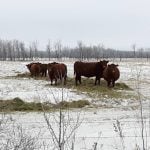A highly virulent strain of Porcine Reproductive and Respiratory Syndrome virus has pork officials stressing the importance of surveillance and vaccination programs.
There is also a need for a co-ordinated approach, industry officials from Ontario and the U.S. Midwest said during a recent webinar.
Although there are hundreds of strains of the virus, Dr. Marty Misener of South West Ontario Veterinary Service said his practice, which focuses solely on swine health, sees three predominant strains in the province: 1-1-1, 1-201-1 and 1-8-4. The 1-8-4 is a “very, very virulent strain” and the one causing the most significant loss, he said.
Read Also

Manitoba Ag Days 2026: Local businesses gear up for Brandon farm show
Most of agriculture is seemingly at Manitoba Ag Days each January: Manitoba agribusinesses and farm groups look forward to connecting with farmers at the 2026 show.
“Our industry should actually single out some very specific strains and throw a bunch of work at those strains,” said Misener.
The Porcine Reproductive and Respiratory Syndrome (PRRS) virus was likened to “a pig equivalent to COVID-19” in an article posted on Genome Alberta’s website earlier this year.
“In North America alone, PRRS costs the pork industry hundreds of millions of dollars annually,” the article states. “To make matters worse, the virus mutates quite readily, producing thousands of strains and making vaccination difficult.”
Misener’s clinic looked at testing data from January 2016 to April of this year and found a “significant” increase in positive cases within the last 16 months (19 per cent versus 15 per cent previously).
Although vaccination can help prevent pigs from being infected with the highly transmissible virus, “Here in Ontario, we haven’t been super aggressive with utilizing PRRS vaccine,” Misener said.
“But with continued pressure and more outbreaks and prevalence, I believe we need a rethink and be more aggressive in using that tool in the best way we possibly can,” he said. “I suggest everybody scratch their head and think about where that’s applicable to your farm in very pig-dense areas.”
The biggest hurdle to eliminating the virus is finding out how it’s transmitted.
“There is no smoking gun,” said John Otten, swine production manager with Floradale Feed Mill in southern Ontario.
He spoke of a farm in his area that dealt with the virus last summer despite having a consistent sow herd with “leading-edge performance.” In the last 18 years, the farm has had four infections, all successfully eliminated. It has experienced staff, exposes gilts early in life to a modified-live PRRS vaccine and produces PRRS-negative pigs with surveillance at the nursery.
But last June, some sows started going off feed “and by the third day, we knew we had some suspicion,” he said. Testing confirmed the presence of the 1-8-4 strain, which brought “high and fast mortality” in the farrowing rooms, as well as rapid sow and pregnancy losses. Some nursery groups experienced 20 per cent mortality.
Knowing it was an aggressive strain, “we knew it would be a haul to get the herd stabilized,” he said.
The farm monitored lactation, ambient temperature, piglet deaths and stillborns and reviewed biosecurity protocols for staff and suppliers but was unable to find the cause.
The variant is causing much higher levels of morbidity and mortality, said Mark Schwartz, manager of production systems for Schwartz Farms Inc., a family-owned producer with 6,000 sows and 14 sites in Minnesota, Nebraska, South Dakota, and Iowa. It, too, undertook an extensive review of production and pig movement, as well as suppliers that service other farms without finding the means of transmission.
“It’s been a very frustrating and humbling experience,” he said.















